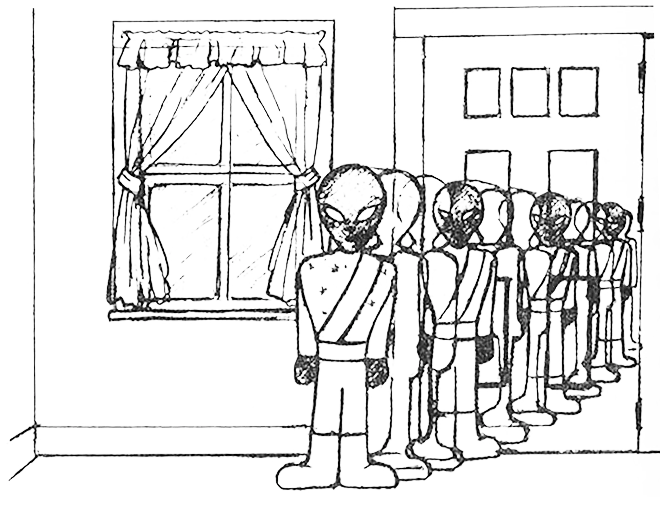Betty Andreasson: Humble Messenger of Extraterrestrial Agenda, Part 1
Subjected to alien abductions, and travel to a distant home world, she passed every truth test administered to her.
This is a story about a series of alien abductions, but much, much more.
May I set the personal stage for this encounter?
New York City in the 1970s was not just a place; it was the largest unscripted performance space in the solar system. It had everything and everyone, and all the knowledge the world could accumulate was stored in the city in one place or another. The NY Public Library was the world's largest; it also had the largest collection of galleries and museums on earth. And several special places that have not been celebrated publicly.
One of these temples was on 17th Street, in the form of a bookstore called Barnes and Noble, and to me, it was better than Disney's Magic Kingdom.
Every time I went there, I would emerge, like knowledge-seeking Grasshopper, with a stack of books that felt heavy and hot, like the fuming iron cauldron in the TV show, Kung Fu.
It was in that world of knowledge, that as a teenager I discovered books detailing the insanity of life elsewhere on the planet. Peculiarly (and perhaps because some years earlier, I had experienced what Communism had done to my family in Cuba) I remember the sweeping Aleksandr Solzhenitsyn text The Gulag Archipelago that was both an inventory and history of the Soviet Union's forced labor camps system. Solzhenitsyn's voice had the tone of a traveling anthropologist. It was almost bureaucratic in its coldness, but in fact, it was the voice of a prisoner, written after Solzhenitsyn had spent years in the Russian penal system, being shuttled from one prison camp to another. Try this moment, from page 645, for size:
And you, hurrying along the platform with your children, your suitcases, and your string bags, are too busy to look closely: Why is that second baggage car hitched onto the train? There is no identification on it, and it is very much like a baggage car—and the gratings have diagonal bars, and there is darkness behind them. But then why are soldiers, defenders of the Fatherland, riding in it, and why, when the train stops, do two of them march whistling along on either side and peer down under the car?
The train starts—and a hundred crowded prisoner destinies, tormented hearts, are borne along the same snaky rails, behind the same smoke, past the same fields, posts, and haystacks as you, and even a few seconds sooner than you. But outside your window even less trace of the grief which has flashed past is left in the air than fingers leave in water.
At this point, Solzhenitsyn is sharing a memory from just after the first half of the 20th century, when most of the industrialized world has had all manner of immigrants, refugees, escapees, and prisoners in transit throughout the slapdash post-War quilt that was Europe.
Let us bid so long to Monsieur Solzhenitsyn for now (although one senses echoes of a return to that kind of dictatorial sadism these days). What other worlds did I discover in that bookstore? Dozens of them, including many classics of philosophy and psychology. One year, my life was altered by discovering what can only be called Germanic rigor, first in the form of Immanuel Kant’s Critique of Pure Reason, and later Sigmund Freud’s The Interpretation of Dreams, then later still, works by Carl Jung, and in their entirety, books by the (non-German) mystic G.I. Gurdjieff, all of whom expressed the most persuasive skepticism that reality as we know it, and our consciousness of it, are in crucial ways extremely incomplete because our knowledge (the bridge between objective reality and subjective consciousness) is limited and fragmentary. All of these great minds – Kant, Freud, Jung, and Gurdjieff – make clear that our senses are not reliable instruments of reality, and I realized that if these four heavyweights are so convinced of this that they are moved to write lengthy treatments of the problem, then, to ignore this blindness is – as Gurdjieff said – to live life in a state of sleep.
At that Barnes & Noble, over those early years, of all the books I found that anchored my reasoning in something greater than what is here and now before our eyes, none was more world-shaking than Raymond Fowler’s The Andreasson Affair.
In the first of several books – each built around a set of extended hypnotic regressions – Fowler (a former Special Agent with the U.S. Air Force’s elite Office of Special Investigations) takes us through these sessions and a sequence of bizarre UFO communications and abduction experiences lived and told by Betty Andreasson Luca, a humble and religious mother of seven children living a quiet life in the small, wooded town of Ashburnham, Massachusetts, just south of the New Hampshire border.
Betty’s was not the first case in the history of such abductions, but it was the most informative. In addition to many hours of subconscious recollection of these experiences, Betty had both the talent and presence of mind to depict key moments in her interactions with aliens in a series of carefully made drawings from which we can glean more detail than we could even now unpack or understand.
Early on, for example, we read her hypnotically induced recollection of what (she thought) was her first encounter with aliens in 1967, as they materialized through the front door while she was making supper for her family. Here is a recording of a broadcast where Ray Fowler explains the phenomenon, and at minute 5, we can hear Betty’s voice in a hypnotic session. The drawing she made of this incident shows a mirror-like procession of small beings appearing through a closed door:
This image remains galvanized in my memory. It was an unforgettable introduction as I realized that this book was going to be a wild ride into consciousness; way past any groundwork Kant, Freud, Jung, or Gurdjieff had laid down. I’ve mentioned how, from their writings, I already knew that our senses are not reliable instruments of reality. But this was something else entirely, because here was a multiple fork in the road – either I could dismiss her account as a personal hallucination of some kind, or I could believe what she was saying. I wasn’t so closed off as to believe that everything I know is what is, so I opted to believe her, if somewhat cautiously, because one fact is truer than any other: just because we cannot explain or prove something doesn’t mean it never happened. If there were intelligent beings in that house that day, then they would have come from some distance, and would not have had our experiences. They would be from a world of which we know nothing. And in light of this possibility, I realized that my ignorance cannot be placed in a position of authority.
Many years later, I realized that Betty’s drawing of aliens going through solid matter was a visual description of quantum tunneling. We are only at the infancy of how physics works but here are a few minutes that illustrate the wonder of how particles can go through matter:
If we can perform quantum tunneling on a simple scale, a more advanced species of being can do it better, and going through that door now doesn’t seem as unlikely as it did when I read about it those many years ago.
At the center of Betty’s experiences is something that many – or even most – abductions lack: mutual communication. Betty was brought on board the alien ship, she traveled to the beings’ planet, experienced a form of self-transcendence, and on various occasions, was seemingly subjected to a kind of secret message download meant only for her subconscious. What they told her, however, is what is truly unique.
Having set the stage for sharing Betty’s experiences, let us continue in our next article, in which we explore what the aliens told her.









